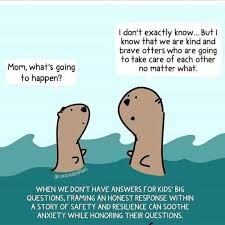"Being the Calm"

BEING THE CALM
If there is anything that all parents have in common is an insatiable desire to protect
our children. It is an instinct unlike no other. Just a quick scroll through the news or
social media instills an unfathomable fear of impending risk to our children and with
that fear is a deep knowing that there is literally nothing we would not do to protect
them.
When frightening things happen in the world, or even in our community, we are often
torn about what to say and how much information to share to reassure our children
that they are safe. Honesty is ALWAYS best. Stick to the facts and what we know to be
true. Consider the age and maturity level of the child. Not every child can handle all
the details of every scary or stressful situation.
In 24 years of crisis and trauma work with families, the most common needs I hear
children express:
Am I safe?
Can I trust the adults in my life?
When can things go back to normal?
How we discuss frightening situations with our children can impact their beliefs
about the world we live in. Will we focus on fear and all the bad things that COULD
happen? Or will we focus on the good people who are working at keeping the world
safe? As the safe adults in our children’s lives, our message should be: scary things
may happen in this world but together, as family, school, community, we are strong
enough to handle it.
WHAT CAN WE DO TO CREATE CALM FOR OUR CHILDREN?
We can point out the good we see everyday, particularly amidst a crisis: look for the
heroes and the helpers; look for kindness, bravery and courage.
We can remind our children that most people are good and kind and have no
intention of hurting them.
❖ We can monitor the amount of negative news and social media we ingest as a
family.
❖ We can take time to self-reflect about our own feelings and behaviors. We are
the models for our children and they will follow our lead.
❖ We must ask ourselves: are we adding to the stress or are we creating calm?
❖ We can ensure that our words match our behaviors. Are we saying to our
children that everything is okay and not worry, yet they watch us cry or act
angry? If our children do hear our voice tremble or see tears, it's important we
are comfortable with our emotions and concerns, then explain our feelings
AND reassure them we love them and will support them always.
❖ We can be sure to keep the focus on our children’s feelings and not to make
stressful situations about US.
❖ Most importantly, as parents, our children need to know that we are always
available to them, check in with them often and answer their questions
honestly and appropriately.
If you find your feelings of anxiety and fear do not go away, access professional and
community resources. Kids’s Help Phone www.kidshelpphone.ca/resources-around-me or
call 1-800-668-6868, Mental Help Line 1-877-303-2642 or crisis support
www.alberta.ca/individual-family-crisis.
This article was submitted by Tammy Charko BA, BSW, RSW. Tammy is Northern Gateway Public School’s Student Support Facilitator. She is a support for schools, students, parents and caregivers to encourage success in school. Tammy advocates for students and provides a link between the student and other supports within the community. Tammy has been a social worker for over 24 years and is a mother to 4 children.
